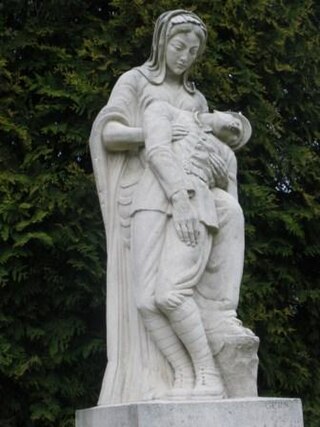
Albert is a commune in the Somme department in Hauts-de-France in northern France.

Hawthorn Ridge Redoubt was a German field fortification, west of the village of Beaumont Hamel on the Somme. The redoubt was built after the end of the Battle of Albert and as French and later British attacks on the Western Front became more formidable, the Germans added fortifications and trench positions near the original lines around Hawthorn Ridge. At 7:20 a.m. on 1 July 1916, the British fired a huge mine beneath the Hawthorn Ridge Redoubt. Sprung ten minutes before zero hour, the mine was one of 19 mines detonated on the first day of the Battle of the Somme. Geoffrey Malins, one of two official war cameramen, filmed the detonation of the mine. The attack on the redoubt by part of the 29th Division of VIII Corps was a costly failure.

Beaumont-Hamel is a commune in the Somme department in Hauts-de-France in northern France.

Tyne Cot Commonwealth War Graves Cemetery and Memorial to the Missing is a Commonwealth War Graves Commission (CWGC) burial ground for the dead of the First World War in the Ypres Salient on the Western Front. It is the largest cemetery for Commonwealth forces in the world, for any war. The cemetery and its surrounding memorial are located outside Passendale, near Zonnebeke in Belgium.

The London Cemetery and Extension is a Commonwealth War Graves Commission cemetery at High Wood near Longueval, France. It is the third largest of the Somme battlefield cemeteries, containing 3,872 World War I burials.

The Beaumont-Hamel Newfoundland Memorial is a memorial site in France dedicated to the commemoration of Dominion of Newfoundland forces members who were killed during World War I. The 74-acre (300,000 m2) preserved battlefield park encompasses the grounds over which the Newfoundland Regiment made their unsuccessful attack on 1 July 1916 during the first day of the Battle of the Somme.

Y Ravine Cemetery is a Commonwealth War Graves Commission burial ground for the dead of World War I situated on the grounds of Beaumont Hamel Newfoundland Memorial Park near the French town of Beaumont-Hamel.
The 51st (Highland) Division Memorial at Beaumont-Hamel is a memorial in France commemorating the soldiers of the 51st (Highland) Division killed during World War I. The memorial is located near Y Ravine on the 84-acre (340,000 m2) Beaumont-Hamel Newfoundland Memorial site. This position had been the scene of the Division's first major victory on 13 November 1916 during the Battle of the Ancre, the closing stage of the Battle of the Somme.

Hawthorn Ridge Cemetery No. 2 is a Commonwealth War Graves Commission burial ground for the dead of World War I situated on the grounds of the Beaumont-Hamel Newfoundland Memorial near the French town of Beaumont-Hamel.

The Plymouth Naval Memorial is a war memorial in Plymouth, Devon, England which is dedicated to British and Commonwealth sailors who were lost in World War I and World War II with no known grave.

George Henry Paulin, often called Harry Paulin, or 'GHP' was a Scottish sculptor and artist of great note in the early 20th century.

Masnieres British Commonwealth War Graves Commission Cemetery is a small Commonwealth War Graves Commission (CWGC) burial site for British Empire troops killed during the First World War Battle of Cambrai (1918) between September–October 1918. It also contains a number of German graves, although these are mostly unidentified.
Mill Road Cemetery is a Commonwealth War Graves Commission burial ground for the dead of World War I situated near the French town of Thiepval.

The Capture of Beaumont-Hamel was a tactical incident that took place during the Battle of the Somme in the Battle of the Ancre (13–18 November) during the second British attempt to take the village. Beaumont-Hamel is a commune in the Somme department of Picardy in northern France. The village had been attacked on 1 July, the First Day of the Somme. The German 2nd Army defeated the attack, inflicting many British and Newfoundland Regiment casualties.

The Ancre British Cemetery is a cemetery located in the Somme region of France commemorating British and Commonwealth soldiers who fought in the Battle of the Somme in World War I. The cemetery contains mainly those who died on 1 July 1916 during the first Allied attack on the village of Beaumont-Hamel, on 3 September 1916 during the second Allied attack on the village, and on 13 November 1916 during the capture of the village and the nearby towns of Beaucourt-sur-Ancre and St. Pierre-Divion.

The Beaumont Hamel British Cemetery is a cemetery located in the Somme region of France commemorating British and Commonwealth soldiers who fought in the Battle of the Somme in World War I. The cemetery contains mainly those who died on 1 July 1916 during the first Allied attack on the village of Beaumont-Hamel and in subsequent operations in the area until February 1917.
The Gallipoli Newfoundland Memorial is a war memorial that commemorates the actions of the Royal Newfoundland Regiment during the Gallipoli campaign, of World War I. Located at the southwest end of the Gallipoli Peninsula, Turkey, near Suvla Bay the memorial commemorates the participation of the Newfoundland Regiment in the landing at Suvla Bay on 20 September 1915 with the 29th Division.
This page is based on this
Wikipedia article Text is available under the
CC BY-SA 4.0 license; additional terms may apply.
Images, videos and audio are available under their respective licenses.















